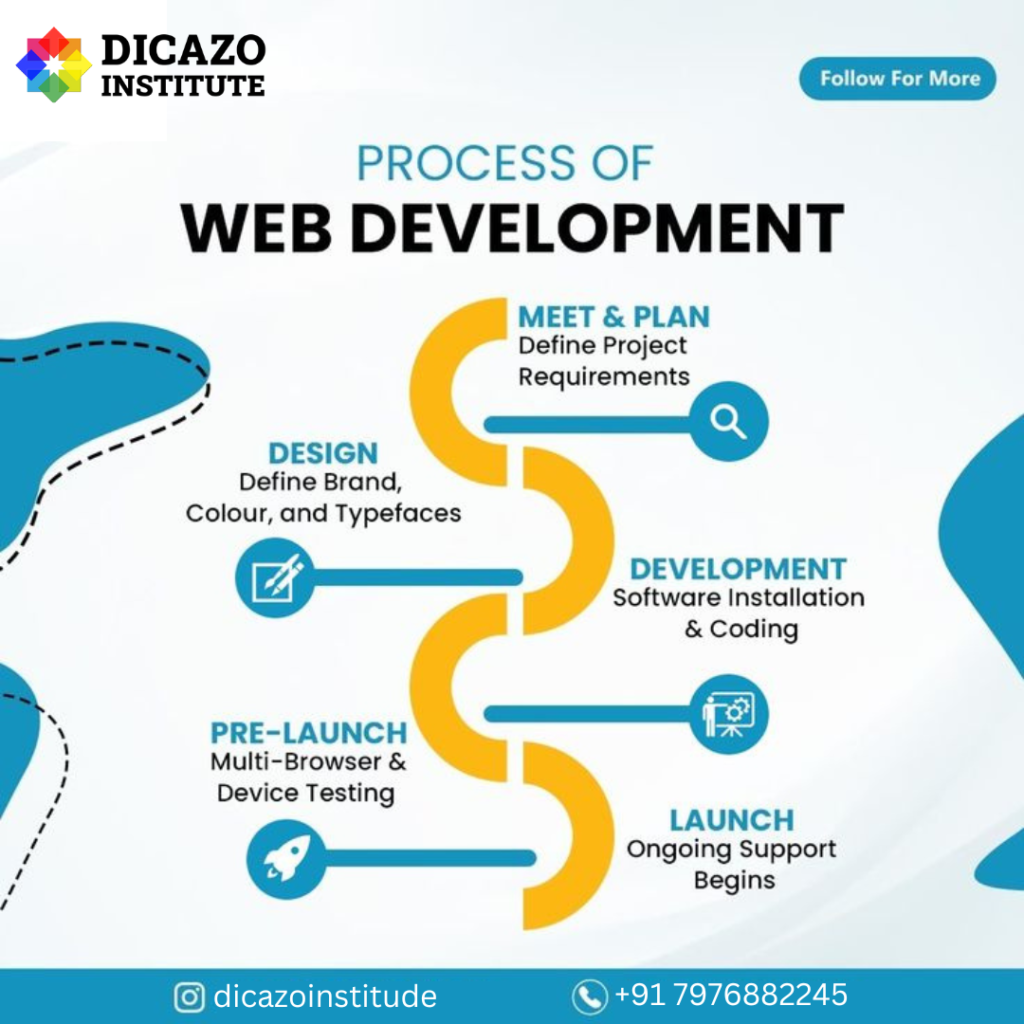Creating a website is an essential skill in today’s digital world. Whether you’re a business owner, a student, or a professional, having a website can help you establish an online presence. At Dicazo, we believe in empowering our students with practical knowledge. This guide is crafted to walk you through the process of building your first website—step by step—so you can get started with confidence.

1. Define Your Website’s Purpose
Before diving in, it’s crucial to identify why you need a website. Ask yourself:
- Is it for a personal blog, a professional portfolio, or a business?
- What features do you want on your site, such as a contact form, image gallery, or e-commerce store?
Understanding your goals will help you make informed decisions throughout the process.
2. Choose a Domain Name
Your domain name is your website’s unique address on the internet. Follow these tips:
- Keep it simple, memorable, and relevant to your purpose.
- Use tools like Namecheap or GoDaddy to check availability.
- Secure your domain through a reliable registrar. Many hosting providers also offer domain registration services.
3. Select a Hosting Provider
A hosting provider stores your website files and makes them accessible online. Here are some common hosting options:
- Shared Hosting: Cost-effective for beginners.
- VPS Hosting: Provides better performance and control.
- Managed Hosting: Great for WordPress users.
Popular hosting providers include Bluehost, SiteGround, and HostGator. Choose one that matches your budget and technical requirements.
4. Plan Your Website’s Layout and Content
Before you start building, sketch out your website’s layout and organize your content. Typical pages include:
- Home: Your landing page.
- About: Information about you or your business.
- Services/Products: Highlight what you offer.
- Blog: Share insights, updates, or articles.
- Contact: Provide ways for visitors to reach you.
Creating a sitemap can help structure your website logically.
5. Choose a Website Builder or CMS
A website builder or Content Management System (CMS) makes the creation process easier:
- Website Builders: Tools like Wix, Squarespace, and Weebly are user-friendly with drag-and-drop interfaces.
- CMS Platforms: WordPress, Joomla, and Drupal offer flexibility and scalability, ideal for more complex sites.
Our institute provides hands-on training with popular platforms to equip you with real-world skills.
6. Install Your CMS or Set Up the Builder
If you choose a CMS like WordPress:
- Log into your hosting control panel and install WordPress with one click.
- Browse and select a theme that aligns with your website’s purpose.
For website builders, simply sign up, choose a template, and start customizing.
7. Customize Your Design
Designing your website is where creativity meets functionality:
- Use your brand’s colors, fonts, and logos to create a cohesive look.
- Ensure your design is mobile-responsive.
- Keep the layout clean and intuitive for a better user experience.
8. Add Essential Features
Your website should be functional and engaging. Consider adding:
- Contact Forms: Make it easy for visitors to reach you.
- Social Media Links: Connect your website with your online profiles.
- SEO Tools: Optimize your site for search engines to attract more traffic.
- Analytics: Tools like Google Analytics help you track user behavior and improve performance.
9. Create and Upload Content
Content is the soul of your website. Include:
- Text: Clear and engaging content that aligns with your audience.
- Images and Videos: High-quality visuals to enhance user engagement.
- CTAs: Encourage visitors to take specific actions, like signing up or making a purchase.
10. Test Your Website
Before launching, thoroughly test your website:
- Check all links and navigation paths.
- Verify the site’s appearance on different devices.
- Use tools like GTmetrix or Google PageSpeed Insights to assess and improve loading speed.
11. Launch Your Website
Once satisfied with your site, publish it and share it with the world:
- Announce the launch on your social media channels.
- Encourage feedback from friends, colleagues, or customers.
12. Maintain and Update Regularly
A website is not a one-time project; it requires regular maintenance:
- Update content frequently to keep it fresh.
- Perform routine backups to prevent data loss.
- Monitor performance and address any technical issues promptly.
- Stay up to date with the latest CMS or plugin updates to ensure security.
Conclusion
Building your first website might seem challenging at first, but with the right guidance and tools, you can create something incredible. At Dicazo, we’re here to help you every step of the way. From understanding the basics to mastering advanced techniques, our courses are designed to give you practical experience and confidence. Start your web development journey today!
More Courses




